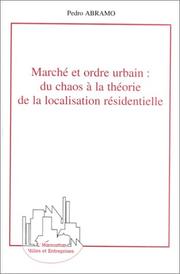| Listing 1 - 10 of 1000 | << page >> |
Sort by
|
Book
ISBN: 9780073511474 0073511471 Year: 2011 Publisher: New York (N.Y.) : McGraw-Hill,
Abstract | Keywords | Export | Availability | Bookmark
 Loading...
Loading...Choose an application
- Reference Manager
- EndNote
- RefWorks (Direct export to RefWorks)
Book
Year: 2022 Publisher: Washington, D.C. : World Bank,
Abstract | Keywords | Export | Availability | Bookmark
 Loading...
Loading...Choose an application
- Reference Manager
- EndNote
- RefWorks (Direct export to RefWorks)
Urbanization and growth of cities are the defining development trends in Uzbekistan, and the country has a unique opportunity to use them as drivers of development. To make the most of the urbanization opportunity, Uzbekistan needs to learn from global experiences, understand the challenges that growing cities face, and act quickly to create favorable conditions for urbanization. While reforms directly affecting urbanization are already underway in Uzbekistan, they can be more effective if they are based on a better understanding of the ongoing urbanization process and its challenges. Government of Uzbekistan initiatives such as the propiska reform, land privatization, and administrative reforms (among others) will have a direct impact on how cities develop, and whether they become drivers of social and economic progress. This report offers an overview of key characteristics of the urbanization process in Uzbekistan and issues associated with it, and thus sets a baseline for detailed work on advancing policy reforms related to urbanization and urban development. The second chapter of the report offers a review of the key outcomes of urbanization in Uzbekistan thus far and opens discussion about the two critical conditions that could be holding Uzbekistan back: factor market distortion and poor urban management. The third chapter presents more detailed analysis of key urbanization trends in Uzbekistan today and demonstrates the channels through which inefficient factor markets and deficient urban management limit the development benefits of urbanization. Chapter 4 digs deeper into these factors that might be causing the inefficient and unsustainable urbanization trends and attempts to identify policy-relevant conditions that might be driving these trends. Finally, chapter 5 discusses key directions for policy reform that are pivotal for effective and sustainable urbanization and urban growth in Uzbekistan.
Book
ISBN: 9264770860 926496178X Year: 2022 Publisher: Paris : Organization for Economic Cooperation & Development,
Abstract | Keywords | Export | Availability | Bookmark
 Loading...
Loading...Choose an application
- Reference Manager
- EndNote
- RefWorks (Direct export to RefWorks)
This report provides a new perspective on Africa's urban economies that is unique in its breadth and level of detail. Based on data from more than 4 million individuals and firms in 2 600 cities across 34 countries, it presents compelling evidence that urbanisation contributes to better economic outcomes and higher living standards.
Book
Abstract | Keywords | Export | Availability | Bookmark
 Loading...
Loading...Choose an application
- Reference Manager
- EndNote
- RefWorks (Direct export to RefWorks)
Book
Year: 1972 Publisher: Glenview: Scott, Foresman,
Abstract | Keywords | Export | Availability | Bookmark
 Loading...
Loading...Choose an application
- Reference Manager
- EndNote
- RefWorks (Direct export to RefWorks)
Book
Year: 1969 Publisher: Washington: [éditeur inconnu],
Abstract | Keywords | Export | Availability | Bookmark
 Loading...
Loading...Choose an application
- Reference Manager
- EndNote
- RefWorks (Direct export to RefWorks)

ISBN: 9782738453068 2738453066 Year: 1997 Publisher: Paris: L'Harmattan,
Abstract | Keywords | Export | Availability | Bookmark
 Loading...
Loading...Choose an application
- Reference Manager
- EndNote
- RefWorks (Direct export to RefWorks)
Book
ISBN: 9780520027800 0520027809 Year: 1975 Publisher: Berkeley (Calif.): University of California,
Abstract | Keywords | Export | Availability | Bookmark
 Loading...
Loading...Choose an application
- Reference Manager
- EndNote
- RefWorks (Direct export to RefWorks)
Dissertation
ISBN: 9162847058 Year: 2001 Publisher: Göteborg : s.n.,
Abstract | Keywords | Export | Availability | Bookmark
 Loading...
Loading...Choose an application
- Reference Manager
- EndNote
- RefWorks (Direct export to RefWorks)
Book
Year: 2022 Publisher: [Place of publication not identified] : Taylor & Francis,
Abstract | Keywords | Export | Availability | Bookmark
 Loading...
Loading...Choose an application
- Reference Manager
- EndNote
- RefWorks (Direct export to RefWorks)
This edited volume presents a compendium of emerging and innovative studies on the proliferation of new working spaces (NeWSps), both formal and informal (such as coworking spaces, maker spaces, fab labs, public libraries, and coffee shops), and their role during and following the COVID-19 pandemic in urban and regional development and planning. This book presents an original, interdisciplinary approach to NeWSps through three features: (i) situating the debate in the context of the COVID-19 pandemic, which has transformed NeWSp business models and the everyday work life of their owners and users; (ii) repositioning and rethinking the debate on NeWSps in the context of socioeconomics and planning and comparing conditions between before and during the COVID-19 pandemic; and (iii) providing new directions for urban and regional development and resilience to the COVID-19 pandemic, considering new ways of working and living. The 17 chapters are co-authored by both leading international scholars who have studied the proliferation of NeWSps in the last decade and young, talented researchers, resulting in a total of 55 co-authors from different disciplines (48 of whom are currently involved in the COST Action CA18214 'The Geography of New Working Spaces and Impact on the Periphery' 2019-2023: www.new-working-spaces.eu). Selected comparative studies among several European countries (Western and Eastern Europe) and from the US and Lebanon are presented. The book contributes to the understanding of multi-disciplinary theoretical and practical implications of NeWSps for our society, economy, and urban/regional planning in conditions following the COVID-19 pandemic.
| Listing 1 - 10 of 1000 | << page >> |
Sort by
|

 Search
Search Feedback
Feedback About UniCat
About UniCat  Help
Help News
News